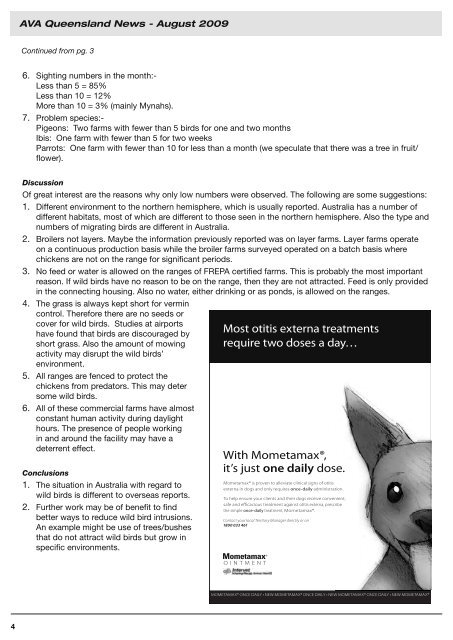Queensland News - Australian Veterinary Association
Queensland News - Australian Veterinary Association
Queensland News - Australian Veterinary Association
- No tags were found...
You also want an ePaper? Increase the reach of your titles
YUMPU automatically turns print PDFs into web optimized ePapers that Google loves.
AVA <strong>Queensland</strong> <strong>News</strong> - August 2009Continued from pg. 36. Sighting numbers in the month:-Less than 5 = 85%Less than 10 = 12%More than 10 = 3% (mainly Mynahs).7. Problem species:-Pigeons: Two farms with fewer than 5 birds for one and two monthsIbis: One farm with fewer than 5 for two weeksParrots: One farm with fewer than 10 for less than a month (we speculate that there was a tree in fruit/flower).DiscussionOf great interest are the reasons why only low numbers were observed. The following are some suggestions:1. Different environment to the northern hemisphere, which is usually reported. Australia has a number ofdifferent habitats, most of which are different to those seen in the northern hemisphere. Also the type andnumbers of migrating birds are different in Australia.2. Broilers not layers. Maybe the information previously reported was on layer farms. Layer farms operateon a continuous production basis while the broiler farms surveyed operated on a batch basis wherechickens are not on the range for significant periods.3. No feed or water is allowed on the ranges of FREPA certified farms. This is probably the most importantreason. If wild birds have no reason to be on the range, then they are not attracted. Feed is only providedin the connecting housing. Also no water, either drinking or as ponds, is allowed on the ranges.4. The grass is always kept short for vermincontrol. Therefore there are no seeds orcover for wild birds. Studies at airportshave found that birds are discouraged byshort grass. Also the amount of mowingactivity may disrupt the wild birds’environment.5. All ranges are fenced to protect thechickens from predators. This may detersome wild birds.6. All of these commercial farms have almostconstant human activity during daylighthours. The presence of people workingin and around the facility may have adeterrent effect.Conclusions1. The situation in Australia with regard towild birds is different to overseas reports.2. Further work may be of benefit to findbetter ways to reduce wild bird intrusions.An example might be use of trees/bushesthat do not attract wild birds but grow inspecific environments.Most otitis externa treatmentsrequire two doses a day…With Mometamax®,it’s just one daily dose.Mometamax® is proven to alleviate clinical signs of otitisexterna in dogs and only requires once-daily administration.To help ensure your clients and their dogs receive convenient,safe and efficacious treatment against otitis externa, prescribethe simple once-daily treatment, Mometamax®.Contact your local Territory Manager directly or on1800 033 461MOMETAMAX® ONCE DAILY • NEW MOMETAMAX® ONCE DAILY • NEW MOMETAMAX® ONCE DAILY • NEW MOMETAMAX®4
















